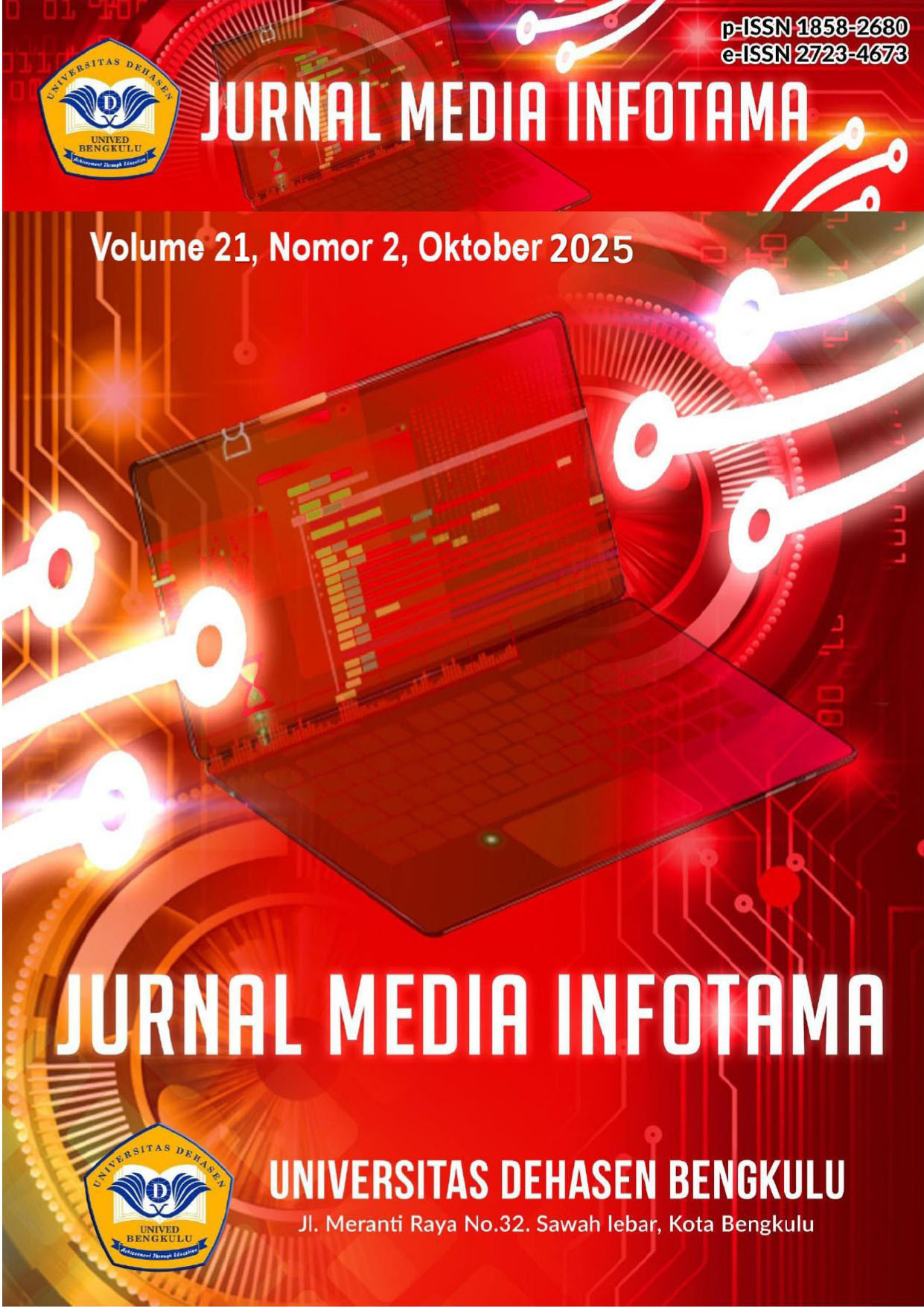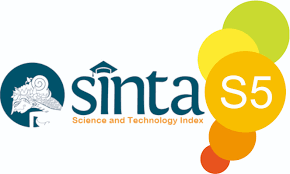Implementasi Metode Naive Bayes Clasifier Untuk Klasifikasi Penyakit Periodontal Berdasarkan Data Pasien Pada Puskesmas Pajar Bulan
Abstract
The purpose of this study is to apply the naïve bayes algorithm for the classification of periodontal disease at the Dental Polyclinic of the Pajar Bulan Health Center UPTD. Periodontal diagnosis is one of the diagnoses with severe conditions that are often complained about at the Dental Polyclinic of the Pajar Bulan Health Center UPTD. However, the problem at the Pajar Bulan Health Center UPTD is that the dental polyclinic patient data is still mixed in one book without any data grouping. So that it is difficult to determine the type or classification of periodontal disease according to its severity. Therefore, a method is needed that is able to classify the risk level of various periodontal diagnoses that occur at the Pajar Bulan Health Center UPTD so that they can be handled immediately with appropriate actions using the Naïve Bayes method. From the results of the tests carried out, the Naïve Bayes method can be used as a solution in using this system. In its application, this Naïve Bayes method can classify the type of periodontal disease at the Pajar Bulan Health Center UPTD
Downloads
References
[2] D. Kurniawan, F. Eka Febriansyah, and A. Amidya, “Implementasi Pengujian Theorema Bayes Pada Studi Kasus Pemilihan Smartphone Android,” J. Komputasi, vol. 6, no. 2, pp. 11–14, 2018, doi: 10.23960/komputasi.v6i2.1744.
[3] Faisal, M. R. (2021). Seri Belajar ASP. NET: ASP. NET Core MVC & MySQL dengan Visual Studio Code. M Reza Faisal.
[4] I. Purnamasari, “Analisa Klasifikasi Loyalitas Siswa Lembaga Pendidikan Tari dengan Metode Naïve Bayes,” J. Ilm. Komputasi, vol. 19, no. 1, pp. 59–68, 2020, doi: 10.32409/jikstik.19.1.157
[5] Jusniwati. 2019. Aplikasi Sistem Pakar Untuk Mendiagnosa Penyakit Tulang Dengan Menggunakan Metode Bayes. Pelita Informatika Budi Darma, 66- 69.
[6] Latukolan, dkk. 2019. Pengembangan Sistem Pemetaan Otomatis Entity Relationship Diagram Ke Dalam Database. Vol. 3, No. 4. Barawijaya.
[7] M. F. Rifai, H. Jatnika, and B. Valentino, “Penerapan Algoritma Naïve Bayes Pada Sistem Prediksi Tingkat Kelulusan Peserta Sertifikasi Microsoft Office Specialist (MOS),” Petir, vol. 12, no. 2, pp. 131–144, 2019, doi: 10.33322/petir.v12i2.471.
[8] Mardi, Y. (2019). Data Mining Rekam Medis Untuk Menentukan Penyakit Terbanyak Menggunakan Decision Tree C4. 5. Jurnal Sains dan Informatika: Research of Science and Informatic, 4(1), 40-53.
[9] Munif, A. 2018. Basis Data. Malang : PT. Elek Media Komputindo
[10] Muttaqin. M, dkk. 2019. Data Flow Diagram (DFD) Design For The Development of Information Retrieval System (IRS) of Research Document Using Non-Relational Database. Yogyakarta : UGM
[11] Nabila, Z., Isnain, A. R., Permata, P., & Abidin, Z. (2021). Analisis data mining untuk clustering kasus covid-19 di Provinsi Lampung dengan algoritma k-means. Jurnal Teknologi Dan Sistem Informasi, 2(2), 100-108.
[12] Pratiwi, A. M., & Mutaqin, A. K. (2020). Penerapan Algoritma Naïve Bayes Classifier dalam Memprediksi Status Keberlanjutan Polis Nasabah Asuransi PT. X. Jurnal Riset Statistika, 1(2), 117-126.
[13] Rahayu, S., & RMS, A. S. (2018). Penerapan Metode Naive Bayes Dalam Pemilihan Kualitas Jenis Rumput Taman CV. Rumput Kita Landscape. Digital Zone: Jurnal Teknologi Informasi Dan Komunikasi, 9(2), 162-171.
[14] Rerung, R. R. (2018). Penerapan data mining dengan memanfaatkan metode association rule untuk promosi produk. J. Teknol. Rekayasa, 3(1), 89.
[15] Sanjaya, U. P., Pribadi, T., & Prastya, I. W. D. (2022). Klasifikasi Dana Hibah Usaha Mikro Kecil dan Menengah dengan Metode Naïve Bayes. Indonesian Journal of Computer Science, 11(3).
[16] Yuliana, Y., Paradise, P., & Kusrini, K. (2021). Sistem Pakar Diagnosa Penyakit Ispa Menggunakan Metode Naive Bayes Classifier Berbasis Web. CSRID (Computer Science Research and Its Development Journal), 10(3), 127-138.
Copyright (c) 2025 Sepriyanto Sepriyanto; Reno Supardi, Yessi Mardiana

This work is licensed under a Creative Commons Attribution-ShareAlike 4.0 International License.
An author who publishes in Jurnal Media Infotama agrees to the following terms:The author holds the copyright and grants the journal the right of first publication of the work simultaneously licensed under the Creative Commons Attribution-Share Alike 4.0 License which allows others to share the work with acknowledgment of the work's authorship and initial publication in this journal.Submission of a manuscript implies that the submitted work has not been previously published (except as part of a thesis or report, or abstract); that it is not being considered for publication elsewhere; that its publication has been approved by all co-authors. If and when a manuscript is accepted for publication, the author retains the copyright and retains the publishing rights without limitation.
For new inventions, authors are advised to administer the patent before publication. The license type is CC-BY-SA 4.0.
MEDIA INFORMATION REVIEW: Journal of the Faculty of Computer Science is licensed under a Creative Commons Attribution-ShareAlike 4.0 International License.You are free to:Share
— copy and redistribute material in any medium or formatAdapt
— remix, modify and develop materialfor any purpose, even commercial.
The licensor cannot revoke this freedom as long as you follow the license terms












.png)


